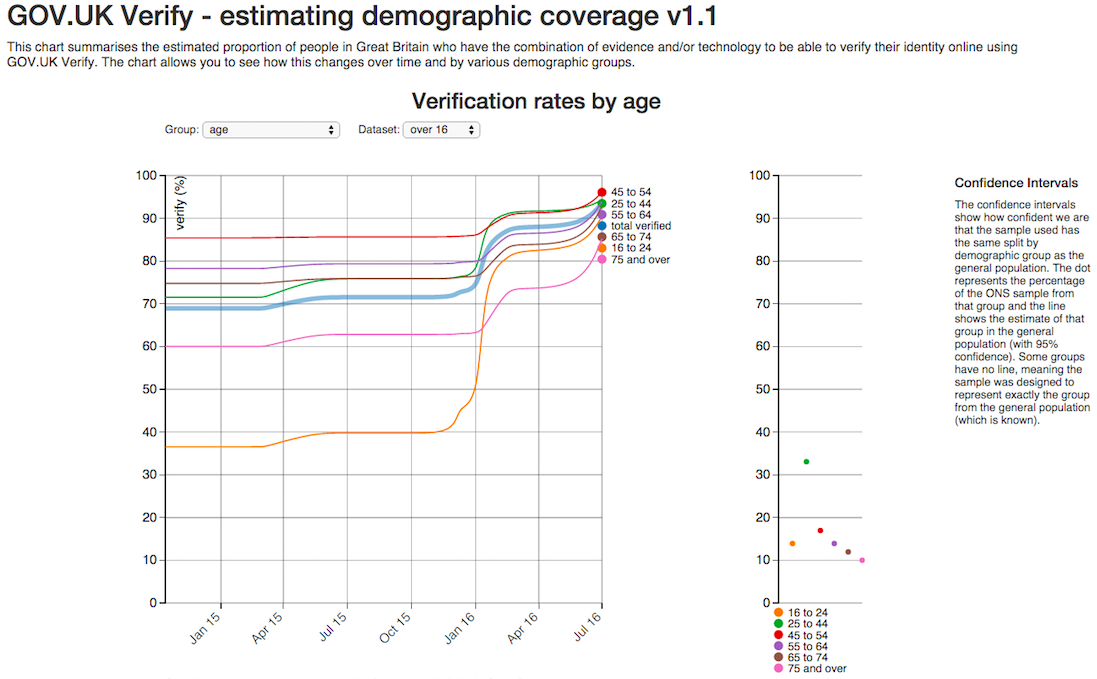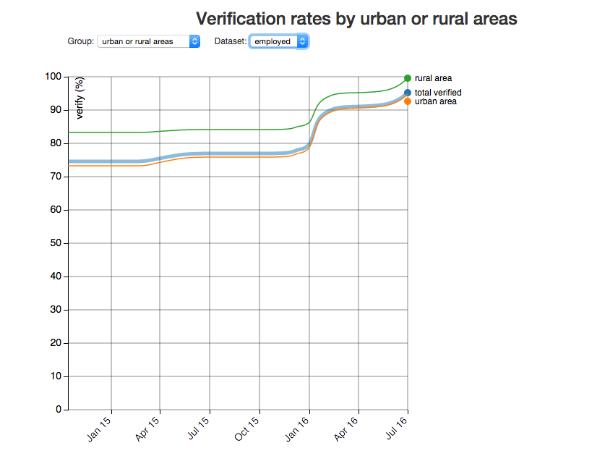One of the targets for GOV.UK Verify is to hit 90% demographic coverage by April. That means 90% of people who are expected to use GOV.UK Verify at that time are able to do so.
We’ve made a tool that shows what proportion of the public will be able to use GOV.UK Verify over the coming months. It’s helping us - that’s the GOV.UK Verify team here in GDS and the services connected to GOV.UK Verify - understand more about our users, as well as showing our certified companies the room they have to innovate.
Reaching the country
Reaching the 90% target means understanding who has the combination of evidence and/or technology to allow us to verify their identity using GOV.UK Verify.
This might mean passports, driving licences, smartphones, tablets or other documentation or equipment. The tool we built helps us understand which people have access to what and where the gaps might be when it comes to reaching that target.
By interviewing people – 2,000 to date – on what evidence and/or technology they have and comparing that to the verification methods used by our certified companies, we’re able to say whether or not people would be able to get verified.
To make this analysis transparent, we're releasing a web tool to let people explore the data as well as underlying data to let people run their own analysis.
We’re also going to release as much of the underlying data as we can under an open government licence with the Office for National Statistics (ONS), while protecting the anonymity of survey respondents.
For more explanation on how we created the tool please see our accompanying blog with the technical detail.
Using the tool
The demographic coverage web tool allows us to explore different groups’ ability to be verified up until GOV.UK Verify goes live in April and then beyond, to summer 2016.
The tool covers data sourced in August and October 2015 by the ONS through this survey. For the broad demographic groups we’re looking at right now, that’s a representative sample.
The tool and the data have already provided us with a number of insights on our users. For example, there may be a greater chance of GOV.UK Verify being able to verify the identity of a user who lives in a rural area compared to one who lives in an urban area. This is because - generally - people who live in the countryside are much more likely to have a driving licence, or use the kind of financial products that create a credit history that our certified companies currently use to verify people online.
With the tool providing clear insights like this, we can further explore how to improve and expand GOV.UK Verify ensuring that, in future, it can cover groups who have less evidence and/or technology.
For instance, users aged 16-24 are less likely to have an established identity footprint. However, many have accounts for charity services like JustGiving, which means that - as a charitable donor - their details have already been verified. We’ve been working with industry through the Open Identity Exchange (OIX) to explore how using these databases might help our younger users.
Finally, the tool is another way our certified companies can see where the gaps in the market might be. Providing more granular information about which groups need to be reached informs the market about where the gaps are. This will help identity providers plan their work on new data and methods to expand demographic coverage. This is just another way GOV.UK Verify is stimulating a market around identity assurance services.
A tool we’ll improve
This is our first iteration. We want to add more demographics, more data, and more ways to analyse the information. At the moment we have nine categories to explore, but we're looking to increase that.
The next round of data should be coming soon, and we're working with data visualisation experts such as Kyran Dale, who built the tool with us, to see how we can analyse that more effectively. In the meantime, please feel free to explore the tool.
Join the conversation on Twitter and don't forget to sign up for email alerts.




5 comments
Comment by Chris S.B posted on
Hi Carrie,
Who are the associated certified companies to date?
Comment by Carrie Barclay posted on
Experian, Digidentity, The Post Office and Verizon are currently connected to GOV.UK Verify, with more due to connect before the service goes live in April.
You can read more about the new suppliers in this blog post: https://identityassurance.blog.gov.uk/2015/03/25/procurement-2-new-identity-suppliers-to-join-gov-uk-verify/
Comment by Lee Jones posted on
When will Verify be available in the Welsh language?
Comment by Carrie Barclay posted on
Welsh language will be available for users of GOV.UK Verify and the associated certified companies.
We anticipate that around the time GOV.UK Verify moves from public beta to live in April 2016 the GOV.UK Verify hub - currently available in English - will also be made available in Welsh.
Welsh speakers verifying their identity and signing in with Digidentity, Experian and Post Office, can already do so in their native language. We expect that all certified companies will offer this option by April 2016.
For user support (e.g. telephone help or live chat help) the current plan is for Welsh language to be available by April 2016 across all certified companies. However, should services demonstrate a need to offer user support in Welsh sooner with the current certified companies, we will discuss this possibility with those identity providers.
Comment by Charles posted on
Lovely. May I recount a story (all true and recent)
UK student goes on Erasmus year abroad to a main French city. Wants to open bank account and as one would expect an online account. Well for this one needs a mobile phone number for the activation code. So you enter your UK phone number to discover that French mobile network runs on 10 digits and it is a 10 digit number required and only 10 digits, no frigging around.
So one goes to get a french SIM. French phone shop: Yes of course sir, and can I have your bank card to set up the contract. No bank card no contract. so it is a holiday short term sim one buys for around 10 euro....... and address etc, well actually one persuades the shop that it is the shop address....
and then 3 months later the bank account finally trawls its way through after a few visits to branch with copy lease etc.....
So, those who think this is a half easy job can see from experience of walking ino life overseas, it is a game and three quarters!.